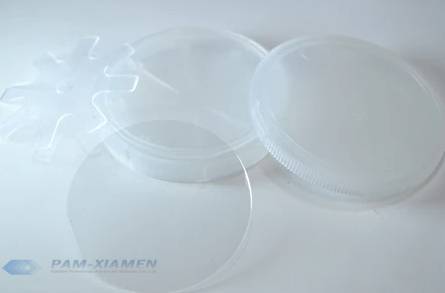AlScN (Aluminum Scandium Nitride) thin film on sapphire or silicon substrate can be provided by PAM-XIAMEN for the application of SAW / FBAR filters, optoelectronic devices, power devices and MEMS. AlScN, a III-V semiconductor based ferroelectric, is a promising semiconductor material at present, which can replace the AlN material in 5G RF field. By doping high content of scandium into aluminum nitride, the piezoelectric performance and electromechanical coupling coefficient of radio frequency devices can be significantly improved. Following is the basic info of AlScN template from us:

1. Specifications of AlScN Template
No.1 Sapphire-based AlScN Template
| Parameters | AlScN Film on C-plane Sapphire Wafer | ||
| Sl. No. | PAM-050A | PAM-100A | PAM-150A |
| Diameter | 2” | 4” | 6” |
| Sc Concentration | 40 ± 15 % | ||
| AlScN Film Thickness | 800 um | ||
| FWHM-HRXRD | ≤120 arcsec | ||
| Ra [5x5um] | ≤10 nm | ||
| TTV | ≤10 um | ≤20 um | ≤20 um |
| Bow | ≤20 um | ≤40 um | ≤60 um |
| Warp | ≤20 um | ≤40 um | ≤60 um |
| Sapphire Substrate | |||
| Substrate Thickness | 430 ± 15 um | 650 ± 20 um | 1300 ± 20 um |
| Orientation | c-axis (0001) ±0.2° | ||
| Usable Area | >95% | ||
| Cracks | None | ||
No.2 Si-based AlScN Template
| Parameters | AlScN Film on C-plane Silicon Substrate | ||
| Sl. No. | PAM-100S | PAM-150S | PAM-200S |
| Diameter | 4” | 6” | 8” |
| Sc Concentration | 40 ± 5 % | ||
| AlScN Film Thickness | 800 um | ||
| FWHM-HRXRD | ≤2° | ||
| Ra [5x5um] | ≤5 nm | ||
| TTV | ≤10 um | ≤5 um | ≤4 um |
| Bow | ≤25 um | ≤40 um | ≤40 um |
| Warp | ≤25 um | ≤40 um | ≤40 um |
| Silicon Substrate | |||
| Substrate Thickness | 525 ± 20 um | 625 ± 15 um | 725 ± 15 um |
| Orientation | c-axis (0001) ±0.2° | ||
| Conductivity Type | N/P | ||
| Resistivity | >5000 ohm | ||
| Usable Area | >95% | ||
| Cracks | None | ||
2. Difficulties and Solutions in Preparation of Heavily Sc-doped Aluminum Scandium Nitride Films
Due to the incorporation of high Sc concentration, the mixing entropy of the ternary nitride alloy is positive, and the film is in a metastable state, which causes the material itself to have a tendency of phase decomposition. Therefore, the preparation conditions for high-Sc-doped and high-quality AlScN films are extremely sensitive, which has become a great problem that restricts the mass production of ferroelectric aluminum scandium nitride thin film and the downstream large-scale industrial applications.
Because Sc, Al, and N do not have solid solubility in thermal equilibrium, it is difficult to prepare Sc-Al or Sc-Al-N alloy targets. In the previous studies, most of the schemes used dual-target sputtering systems to prepare AlScN films. This scheme cannot prepare a thin film with uniform Sc concentration and uniform performance. With the increasing maturity of AlSc alloy target preparation technology, Sc-Al alloy ingots can basically meet the needs of various target materials. Therefore, the magnetron sputtering technology of alloy targets is used to prepare AlScN thin films. In 2010, Japan’s Akiyama et al used Sc0.42Al0.58 alloy targets to successfully fabricate Sc0.38Al0.62N films with a piezoelectric coefficient of 19 pC/N, which were combined with the Sc0.38Al0.62N films prepared by the double co-sputtering method. The piezoelectric constants are basically the same, which confirms the feasibility of AlSc alloy targets for preparing high-voltage electrical ScxAl1-xN films. At the same time, it is proposed that AlSc alloy targets are effective targets for keeping the concentration of scandium in ScxAl1-xN films constant. In 2017, Chiba University in Japan used an AlSc alloy target to grow a Sc0.32Al0.68N film, and successfully fabricated a SAW device with an electromechanical coupling coefficient greater than 2.5% based on the film material. In 2020, the University of Pennsylvania in the United States successfully fabricated a 1.5GHz SAW device with an electromechanical coupling coefficient as high as 4.78% based on the Si-based Al0.68Sc0.32N film.
Increasing the concentration of Sc in the scandium-doped AlN thin film, the structure of the material will also transition from a pure wurtzite structure (AlN structure) to a layered hexagonal structure (ScN metastable phase). This change has been confirmed by experiments. Since it is difficult to determine the initial doping concentration of the phase transition in actual operation, it is difficult to accurately determine the solubility of transition metals in alloy materials. However, the existing literature shows that the solubility of transition metals in AlN is low. Researches on the phase stability and structural characteristics of scandium-doped AlN films show that when the scandium-doped concentration x<56%, the hexagonal wurtzite structure is dominant; when the scandium-doped concentration x>56%, the cubic crystal system is the main structure.
For more information, please contact us email at victorchan@powerwaywafer.com and powerwaymaterial@gmail.com.

